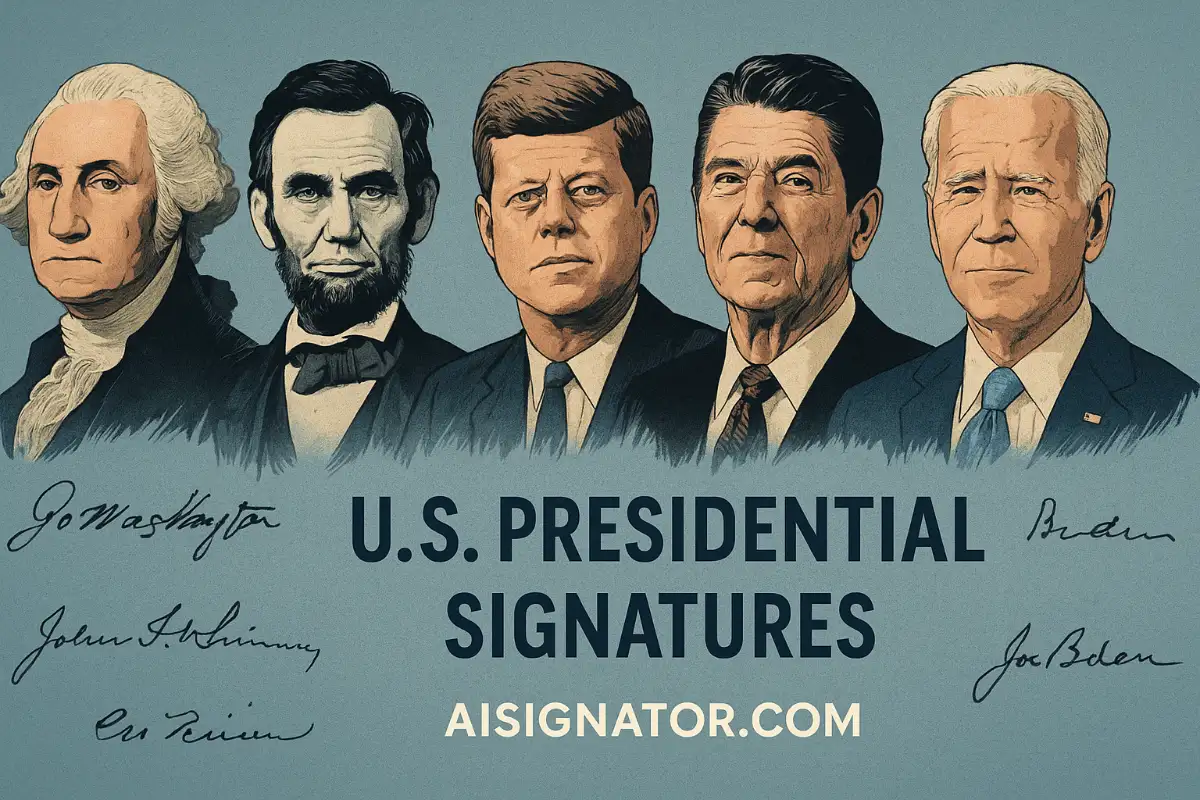The signatures of U.S. presidents are far more than mere scribbles — they are powerful symbols of leadership, identity, and history. From the bold strokes of George Washington to the modern flair of Donald Trump, each autograph tells a story that reflects the era, personality, and political legacy of its signer.
In this curated collection of 47 U.S. presidential signatures, we invite you to explore the unique styles, meanings, and hidden details behind each American leader’s autograph. Whether you’re a history enthusiast, collector, or simply curious about the personal marks of America’s presidents, this guide offers a fascinating window into more than two centuries of leadership.
Get ready to dive into the artistry, symbolism, and legacy captured in every presidential signature.
✨ What Do U.S. Presidential Signatures Have in Common — and What Makes Them Unique?
At first glance, U.S. presidential signatures may appear as a random mix of flourishes, loops, and rushed strokes. But when examined closely, they reveal surprising commonalities and fascinating distinctions that reflect leadership, personality, and historical context.
1. Authority and Confidence
Most presidential signatures share one defining trait: a confident, assertive flow. Whether it’s the crisp penmanship of George Washington or the sweeping curves of Ronald Reagan, these autographs exude self-assuredness — a subtle but powerful mark of someone accustomed to commanding attention and responsibility.
2. Personal Branding Before It Was Cool
Long before “personal branding” became a buzzword, presidents instinctively understood its power.
- John F. Kennedy’s sleek, elegant script mirrored his youthful charisma.
- Abraham Lincoln’s somewhat shaky, deliberate letters reflected his thoughtful, moral leadership during crisis.
- Donald Trump’s towering, jagged signature projected boldness, unpredictability, and media savvy.
Each signature became a visual shorthand for the man behind it.
3. Historical Shifts in Writing Style
Presidential signatures mirror the evolution of American handwriting itself:
- Founding Fathers: Flourished, formal, rooted in colonial penmanship traditions.
- 19th century: More elaborate scripts as penmanship became a mark of education.
- 20th–21st centuries: Simpler, faster strokes, reflecting the urgency of the modern presidency.
This timeline offers a hidden visual history lesson in itself.
4. Hidden Psychological Cues
Experts in graphology — the study of handwriting — suggest that presidential signatures reveal subtle personality traits:
- Size → ego, self-confidence (Trump: oversized; Obama: balanced)
- Slant → emotional expression (Reagan: slightly right-slanted = optimism)
- Pressure → determination (Theodore Roosevelt: strong, dark lines)
- Speed → decisiveness or impulsiveness (Kennedy: fluid; Nixon: erratic)
While not all scientists agree on graphology, it remains a captivating lens through which to view these autographs.
5. The Unmistakable “Signature of Power”
Even when messy or minimalist, presidential signatures command attention because they are attached to immense power. Their meaning doesn’t come just from the ink on paper — it comes from the authority they symbolize. A single stroke could sign treaties, launch wars, or change lives.
📊 Learn how to read the fine details of any signature with our comprehensive signature analysis resource.
🖼️ Complete Collection of 47 U.S. Presidential Signatures
From the stately flourish of George Washington to the bold, unmistakable mark of Donald Trump’s second presidency, each U.S. presidential signature offers a window into the personal style, historical era, and legacy of the leader behind it.
In this complete collection of 47 U.S. presidential signatures, you’ll journey across centuries of American history, exploring how these autographs capture not only the names but also the personalities, ambitions, and symbolism of the nation’s most powerful figures.
Scroll through to discover the distinctive marks that have shaped treaties, executive orders, and historic moments — and to appreciate the art, meaning, and humanity behind every stroke.
📜 Founding Fathers Era (1789–1825)
George Washington
- Term: 1789–1797
- Party: Independent
- Historical role: Founding Father, Commander-in-Chief of the Continental Army, first U.S. president
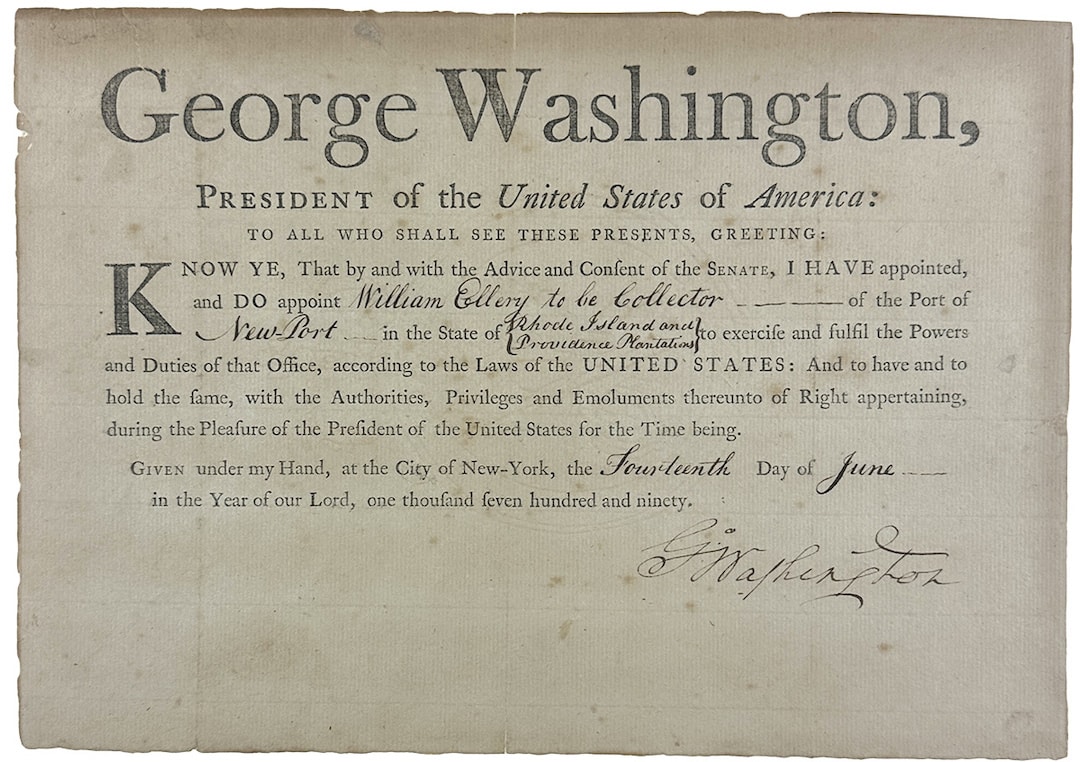
Washington’s signature was elegant, upright, and carefully proportioned, with a bold flourish on the “W” and a distinctive loop on the “g,” reflecting his refined education and sense of duty.
The firm, stately style mirrors Washington’s leadership as a unifying figure in a new nation, embodying honor, restraint, and responsibility. His autograph is one of the most valuable among U.S. presidents, often commanding six-figure prices at auction.
Dive deeper into the elegance of America’s first president. Discover more in our detailed article on George Washington’s signature and historical legacy.
John Adams
- Term: 1797–1801
- Party: Federalist
- Historical role: Founding Father, key figure in the Declaration of Independence, first U.S. vice president
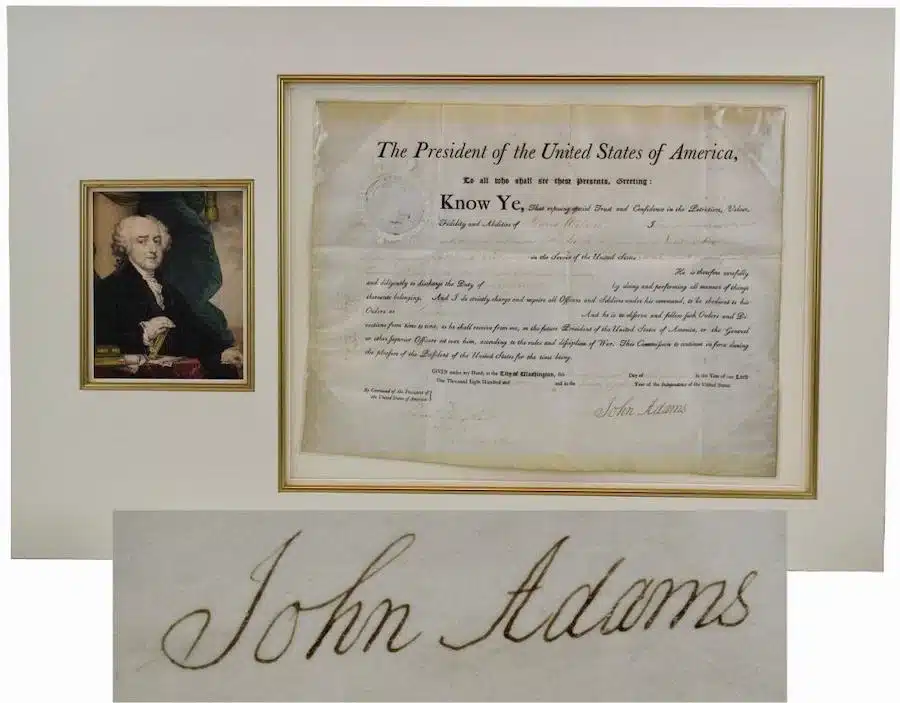
Adams’s signature was strong and angular, with sharply pointed letters and a slightly compressed form, conveying his intense intellect and decisive personality.
The tight, deliberate strokes reflect Adams’s determined, sometimes stubborn character and his deep commitment to republican ideals. John Adams and Thomas Jefferson both died on July 4, 1826 — the 50th anniversary of American independence.
Thomas Jefferson
- Term: 1801–1809
- Party: Democratic-Republican
- Historical role: Author of the Declaration of Independence, third U.S. president, Louisiana Purchase architect

Jefferson’s handwriting was elegant, flowing, and slightly right-slanted, with graceful loops — a hallmark of his refined taste and intellectual depth.
The balanced, fluid style echoes Jefferson’s love of enlightenment ideals, architecture, and harmony in both life and governance. Jefferson invented a “polygraph” copying device, allowing him to create duplicate signatures and letters simultaneously.
James Madison
- Term: 1809–1817
- Party: Democratic-Republican
- Historical role: Father of the Constitution, key author of the Bill of Rights, fourth U.S. president
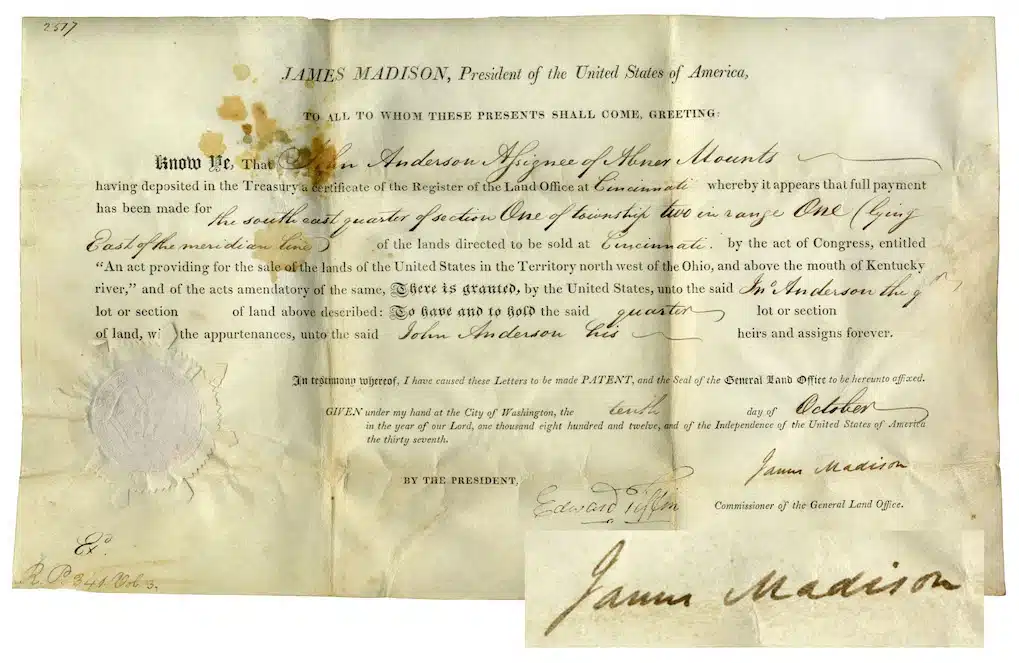
Madison’s script was neat, precise, and compact, with carefully formed letters and minimal flourish, reflecting his meticulous and scholarly nature.
The restrained, thoughtful signature mirrors Madison’s role as a constitutional architect, balancing liberty and order with precision. At just 5 feet 4 inches, Madison was the shortest U.S. president — but a giant in political thought.
James Monroe
- Term: 1817–1825
- Party: Democratic-Republican
- Historical role: Fifth U.S. president, author of the Monroe Doctrine, Era of Good Feelings leader
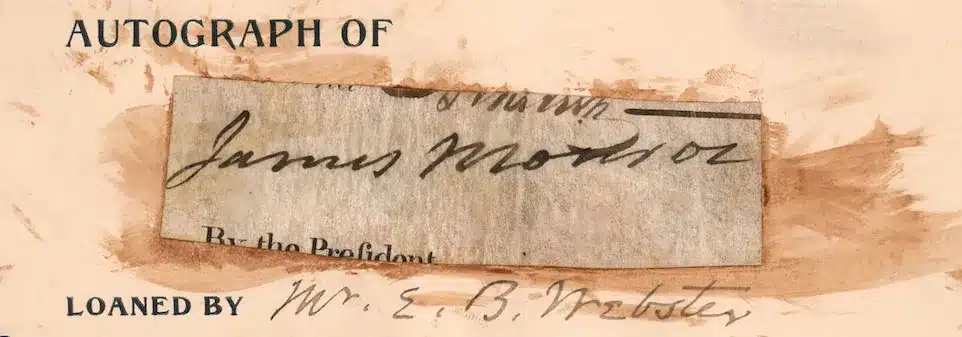
Monroe’s signature was broad and slightly dramatic, with looping “M” and sweeping “J,” capturing his confident statesmanship and optimism.
The expansive style reflects Monroe’s vision of American expansion and unity during a time of national growth. Monroe was the last U.S. president who was also a Founding Father.
⚔️ Expansion & Civil War (1825–1865)
John Quincy Adams
- Term: 1825–1829
- Party: Democratic-Republican / National Republican
- Historical role: Sixth U.S. president, diplomat, son of John Adams
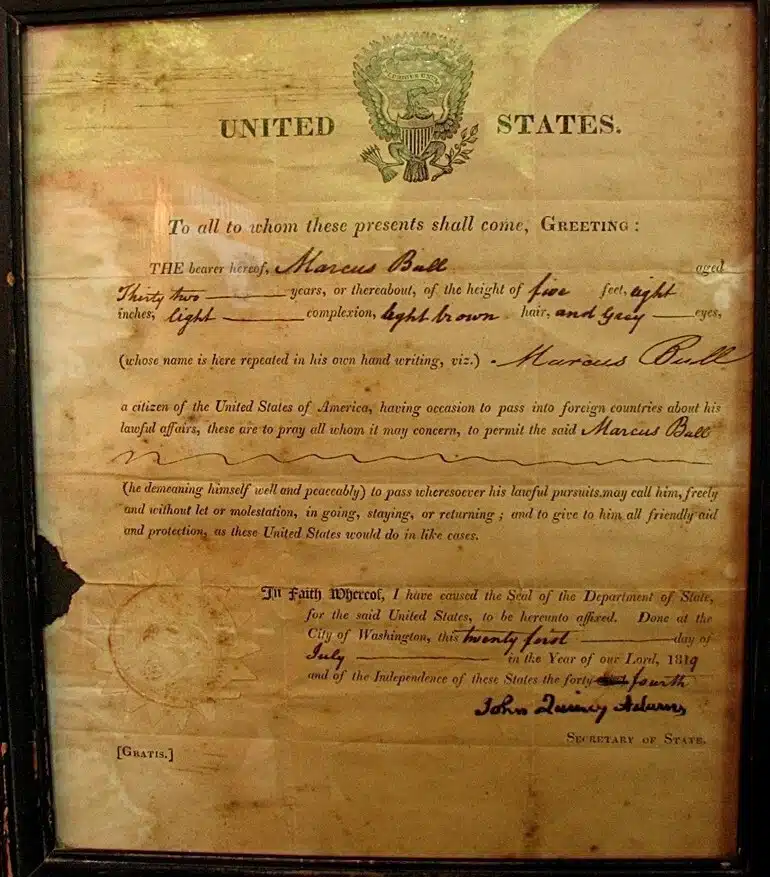
His signature was neat and deliberate, with fine strokes and precise loops, reflecting his disciplined intellect and diplomatic career. The careful penmanship highlights his lifelong dedication to public service and intellectual pursuits.
Andrew Jackson
- Term: 1829–1837
- Party: Democratic
- Historical role: Seventh U.S. president, populist leader, founder of the Democratic Party
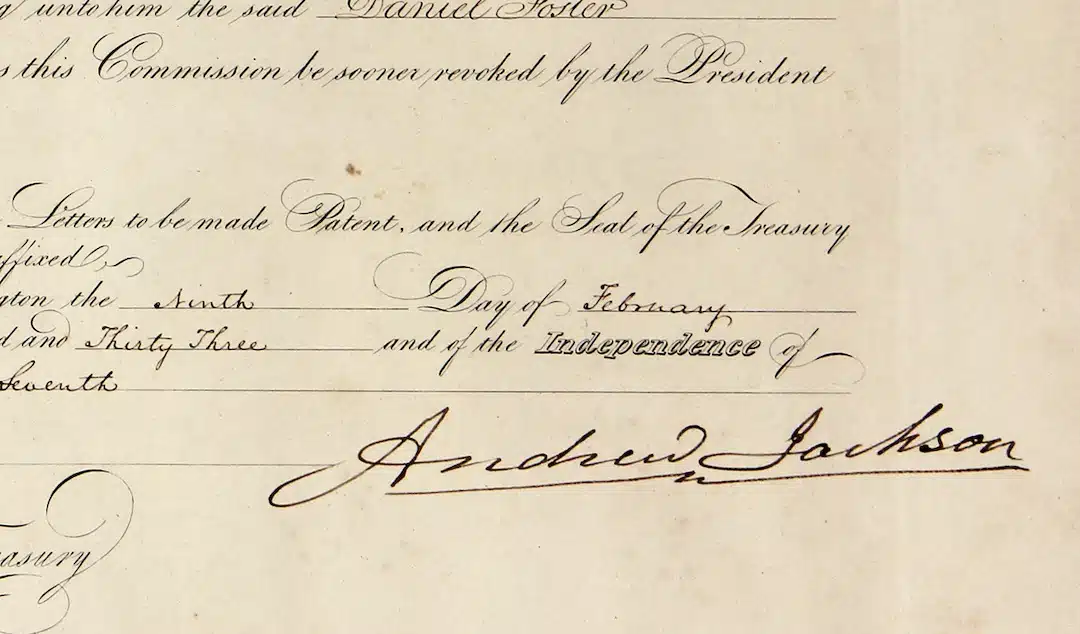
Jackson’s signature was bold and assertive, marked by heavy pressure and strong angles, symbolizing his fierce will and combative spirit. It embodies the rough-and-tumble nature of his presidency and the rise of populist politics.
Martin Van Buren
- Term: 1837–1841
- Party: Democratic
- Historical role: Eighth U.S. president, skilled political organizer
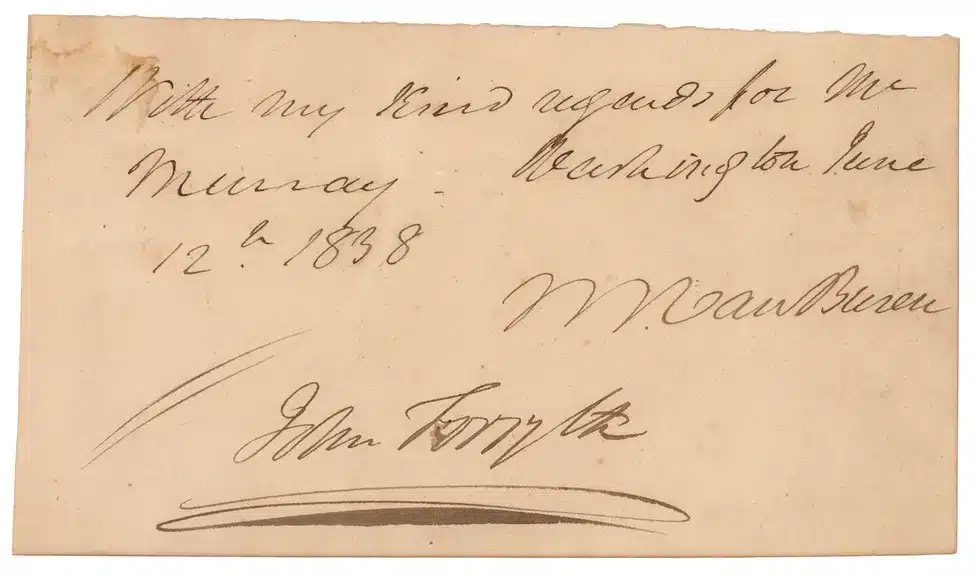
Van Buren’s signature was compact and refined, with elegant loops, reflecting his polished manners and political finesse. The graceful script mirrors his reputation as a behind-the-scenes political mastermind.
William Henry Harrison
- Term: 1841
- Party: Whig
- Historical role: Ninth U.S. president, shortest presidency (died after one month)
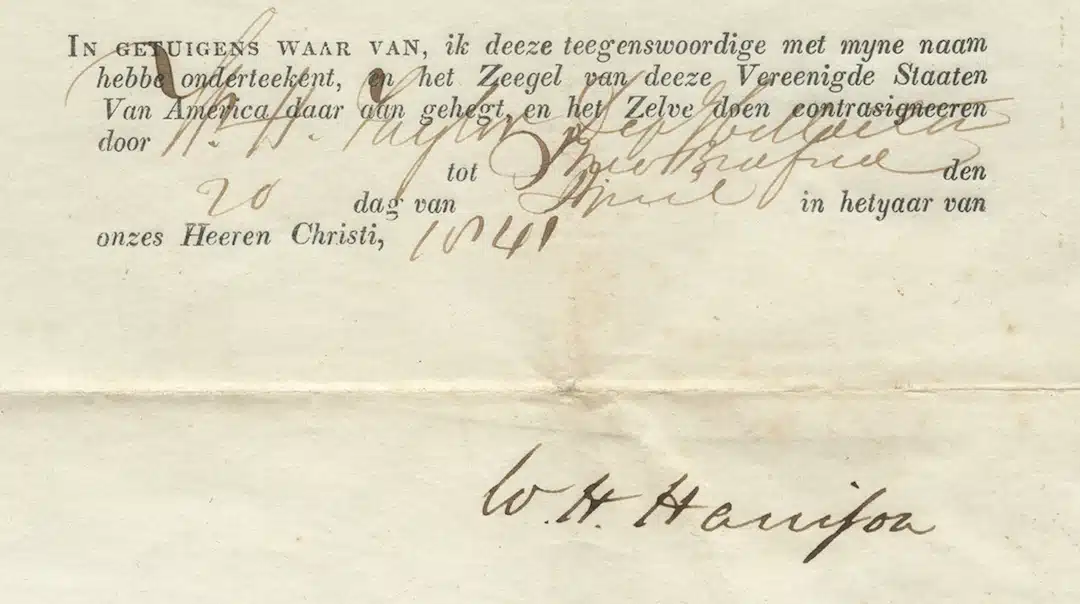
His signature was large and flowing, with sweeping curves, expressing charisma and confidence. Harrison’s grand autograph contrasts poignantly with his brief, tragic presidency.
John Tyler
- Term: 1841–1845
- Party: Whig
- Historical role: Tenth U.S. president, first to succeed after a president’s death
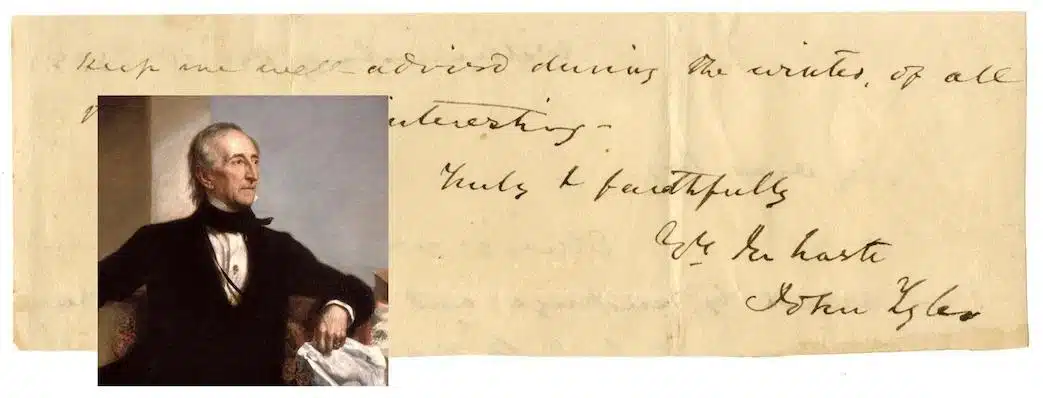
Tyler’s signature was graceful with long, elegant strokes, reflecting his Southern gentlemanly style. The refined hand suggests his emphasis on states’ rights and constitutional principles.
James K. Polk
- Term: 1845–1849
- Party: Democratic
- Historical role: Eleventh U.S. president, champion of expansion (Mexican-American War)

Polk’s signature was tidy and firm, with modest flourishes, conveying precision and focus. It aligns with his reputation as a determined, effective leader who expanded the nation’s borders.
📊 Want to understand more than just the visual style of a presidential signature?
Explore the psychology behind handwriting in our detailed guide to
👉 Handwriting Analysis – uncover hidden personality traits through slant, pressure, rhythm, and spacing.
Zachary Taylor
- Term: 1849–1850
- Party: Whig
- Historical role: Twelfth U.S. president, Mexican-American War hero
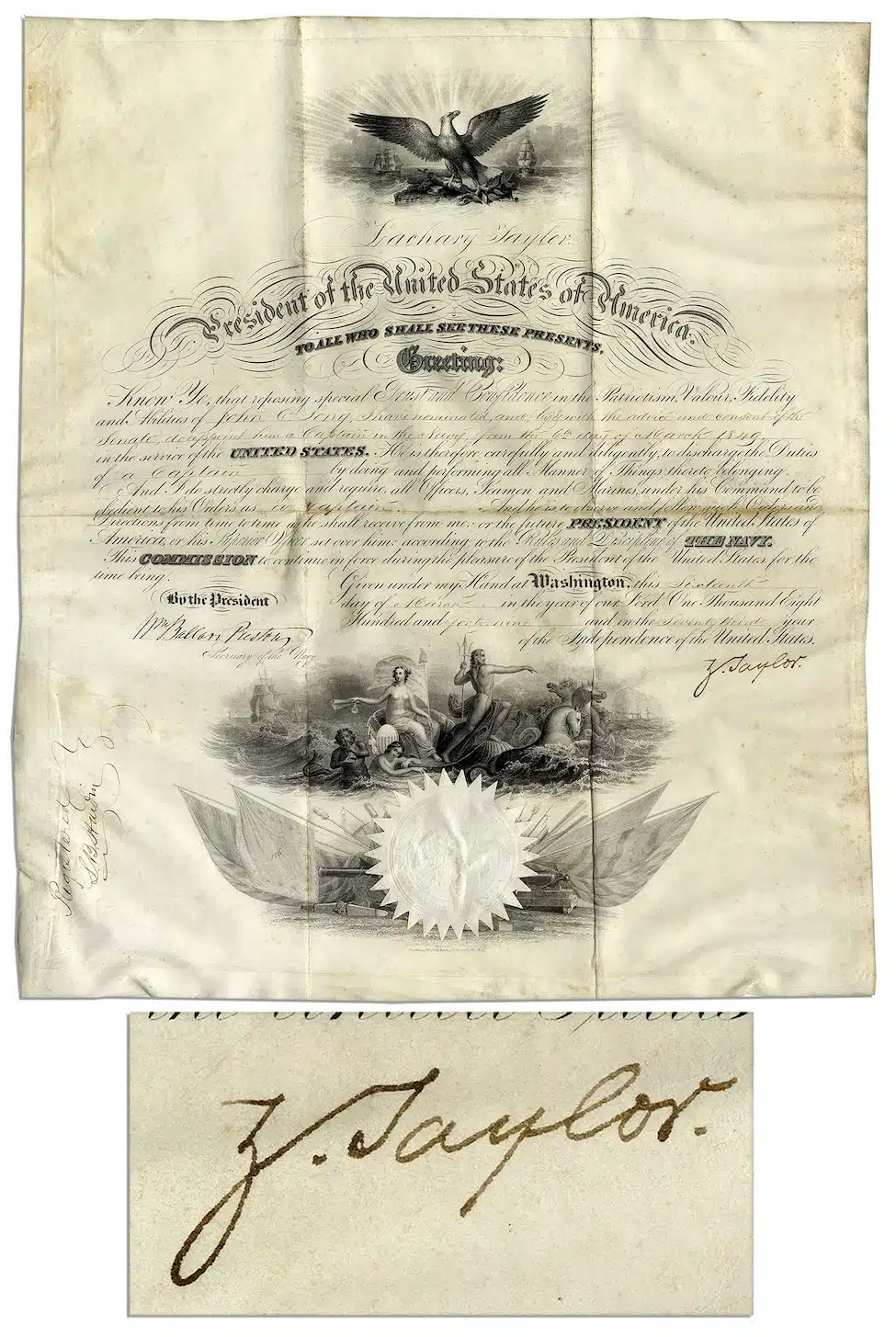
Taylor’s signature was rugged and slightly uneven, reflecting his military background and straightforward character. The unpolished style echoes his image as a no-nonsense, pragmatic leader.
Millard Fillmore
- Term: 1850–1853
- Party: Whig
- Historical role: Thirteenth U.S. president, last Whig in the White House
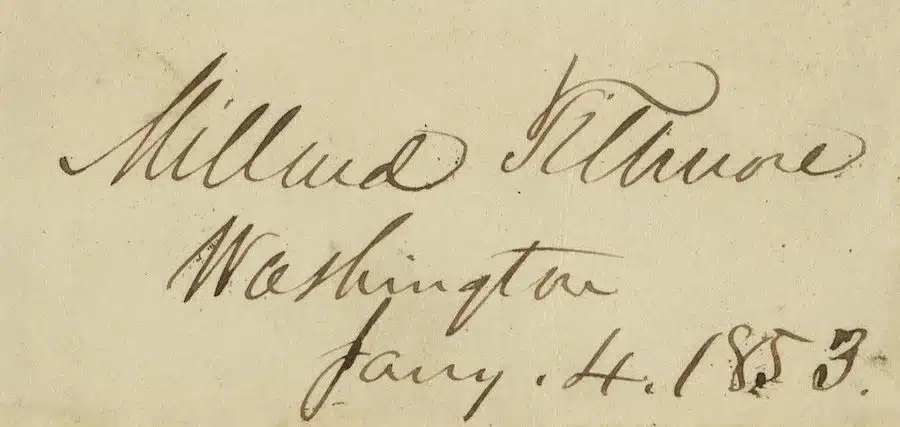
His signature was clean and methodical, with rounded letters and clear structure, showing his orderly mind and legal training. It reflects his reputation as a calm stabilizer in turbulent times.
Franklin Pierce
- Term: 1853–1857
- Party: Democratic
- Historical role: Fourteenth U.S. president, pre-Civil War leader
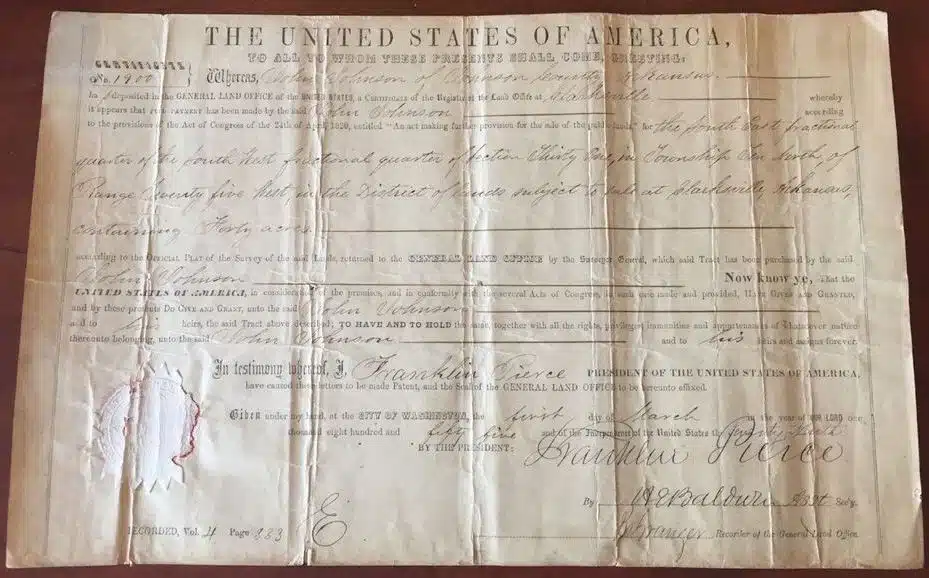
Pierce’s signature was stylish and flowing, with graceful loops and a touch of flair, matching his charm and smooth demeanor. The fluid style contrasts with the challenges and instability of his presidency.
James Buchanan
- Term: 1857–1861
- Party: Democratic
- Historical role: Fifteenth U.S. president, pre-Civil War crisis president
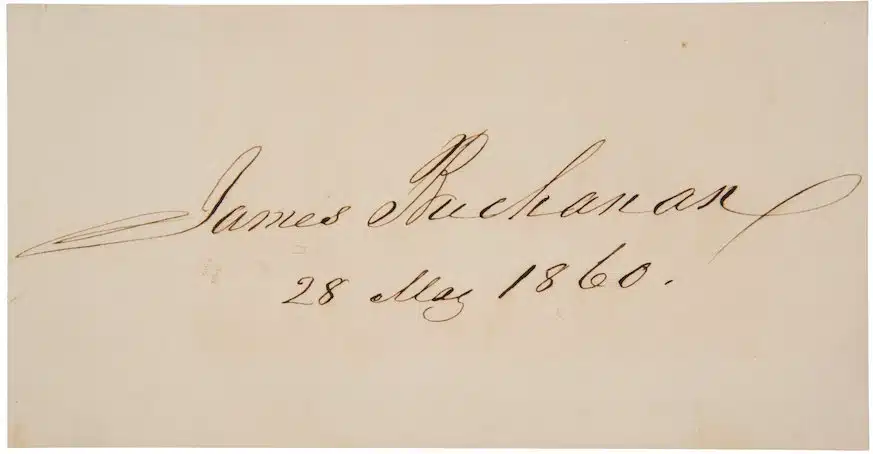
Buchanan’s signature was ornate, with elaborate loops and flourishes, indicating formality and a sense of propriety. The decorative style reflects his old-school diplomacy, though ultimately ill-equipped for the looming national crisis.
Abraham Lincoln
- Term: 1861–1865
- Party: Republican
- Historical role: Sixteenth U.S. president, led the Union during the Civil War, emancipated the slaves
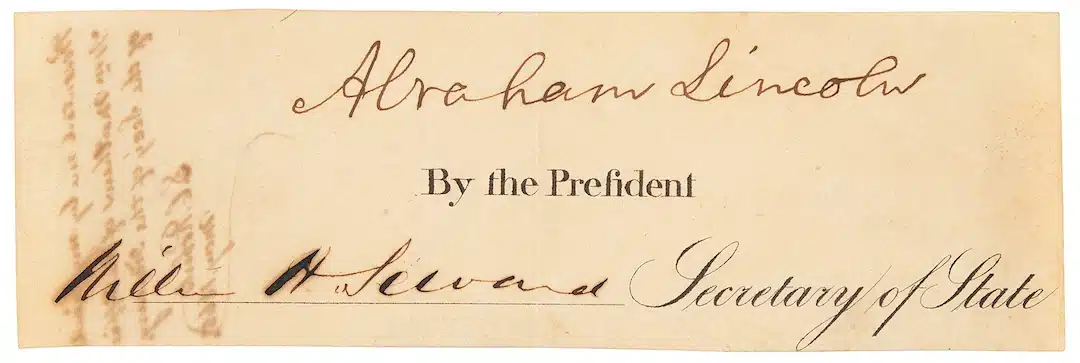
Lincoln’s signature was steady but modest, with elongated letters and minimal embellishment, reflecting humility and strength. The simplicity of his autograph mirrors his plainspoken nature and the weight of guiding a divided nation.
🔧 Reconstruction & Industrialization (1865–1901)
Andrew Johnson
- Term: 1865–1869
- Party: National Union / Democratic
- Historical role: Seventeenth U.S. president, succeeded Lincoln, led Reconstruction
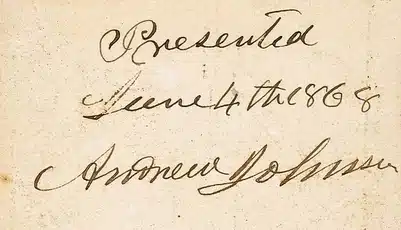
Johnson’s signature was stiff, slightly angular, and occasionally uneven, reflecting his complex, often combative personality. The cautious formation of letters suggests a man under pressure, navigating one of the most turbulent periods in American history.
His handwriting carries the tension of a leader balancing national healing with personal political survival — and ultimately facing impeachment.
Ulysses S. Grant
- Term: 1869–1877
- Party: Republican
- Historical role: Civil War hero, eighteenth U.S. president, led Reconstruction
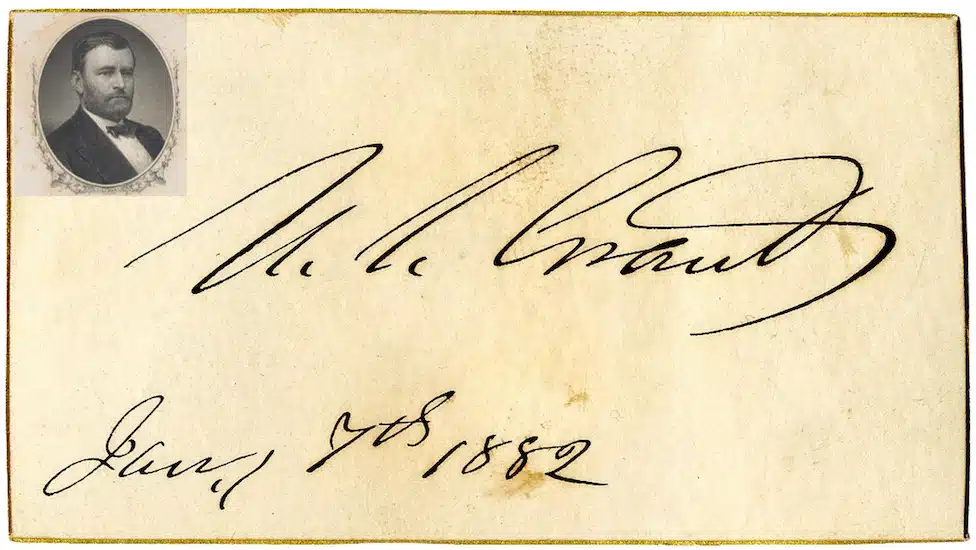
Grant’s signature was bold, rapid, and slightly rough, often appearing as a hurried scrawl rather than polished handwriting. This reflects his military decisiveness and action-first mindset, rather than political polish.
Despite a reputation for personal modesty, his autograph commands presence — fitting for the general who secured Union victory. The contrast between his straightforward nature and the complexity of Reconstruction politics is subtly captured in his firm yet unpretentious penmanship.
Rutherford B. Hayes
- Term: 1877–1881
- Party: Republican
- Historical role: Nineteenth U.S. president, ended Reconstruction, reformer
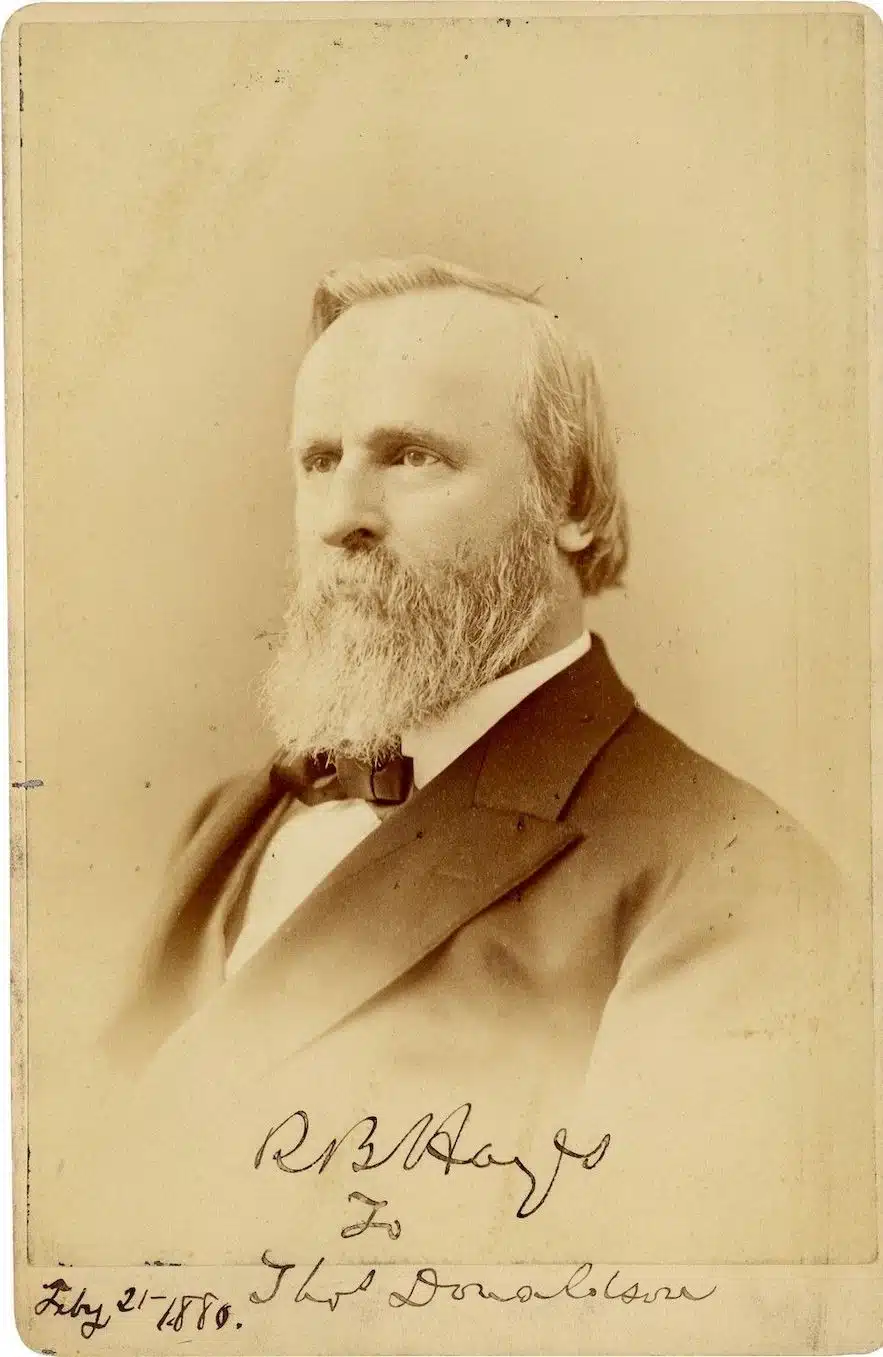
Hayes’s signature was meticulously crafted, with evenly spaced, elegant letters and a slight flourish on the “R.” This suggests a man concerned with order, integrity, and balance — qualities central to his efforts to heal post-Civil War divisions.
The controlled precision of his handwriting mirrors his measured political style, reformist ideals, and careful navigation of a fractious political era.
James A. Garfield
- Term: 1881
- Party: Republican
- Historical role: Twentieth U.S. president, scholar, assassinated early in office
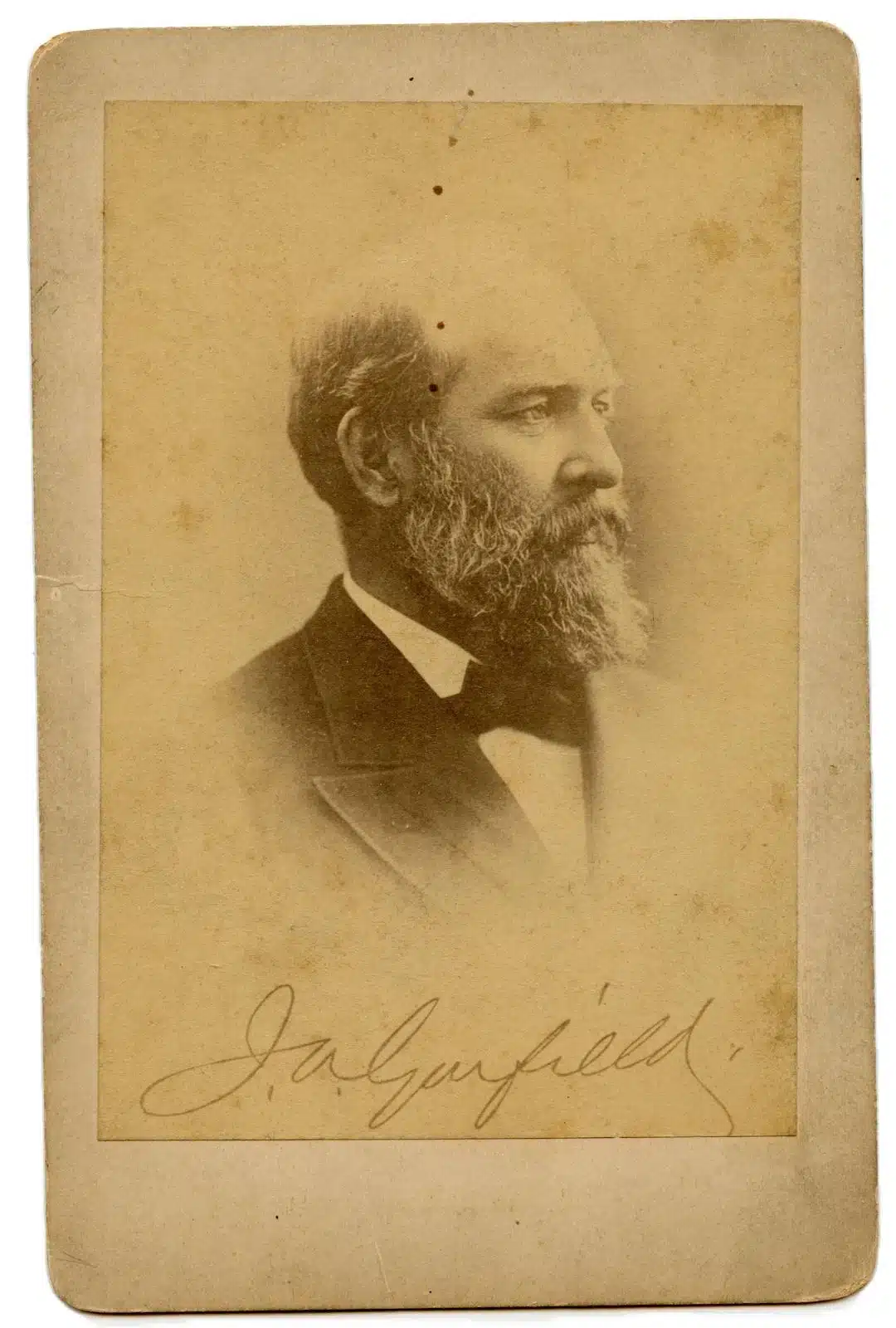
Garfield’s signature was graceful yet firm, with an academic neatness reflecting his background as a classics professor. The thoughtful curves and balanced letters reveal an intellectual temperament, underscoring his deep engagement with education and reform.
His autograph carries a sense of promise tragically cut short, adding poignancy to a hand once poised to lead sweeping change.
Chester A. Arthur
- Term: 1881–1885
- Party: Republican
- Historical role: Twenty-first U.S. president, civil service reformer
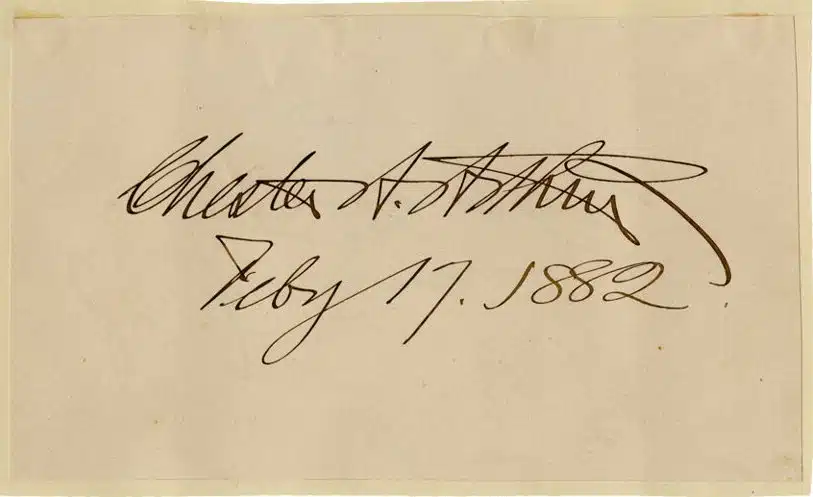
Arthur’s signature was stylish and flowing, marked by refined loops and a subtle flair. Known for his impeccable fashion and personal charm, Arthur’s elegant handwriting reflects his cultivated image.
Yet beneath the surface, the confident strokes hint at his unexpected political evolution — from party insider to reformer challenging corruption within his own ranks.
Grover Cleveland
- Term: 1885–1889
- Party: Democratic
- Historical role: Twenty-second U.S. president, champion of reform and fiscal conservatism
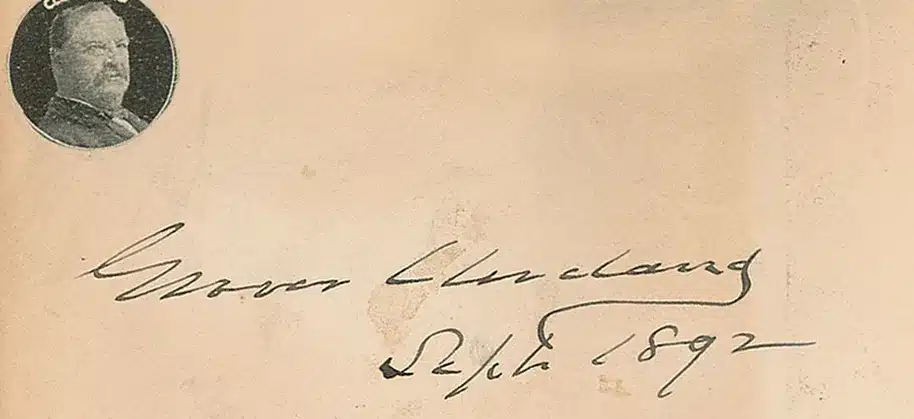
Cleveland’s signature was deliberate, robust, and cleanly executed, with a sense of weight and stability. The strong, practical lettering reflects his reputation as a no-nonsense, principled leader who valued honesty and fiscal discipline.
His autograph suggests a grounded personality, unshaken by political pressure — qualities that helped him earn the public’s trust.
Benjamin Harrison
- Term: 1889–1893
- Party: Republican
- Historical role: Twenty-third U.S. president, grandson of William Henry Harrison
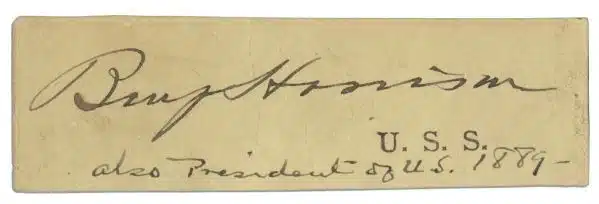
Harrison’s signature was crisp, upright, and slightly formal, showing the influence of his legal background. The precise letterforms and restrained flourishes hint at his meticulous approach to governance and respect for constitutional principles.
Yet the slight rigidity in his penmanship also suggests the challenges he faced connecting with an increasingly diverse and industrialized nation.
Grover Cleveland (2nd term)
- Term: 1893–1897
- Party: Democratic
- Historical role: Twenty-fourth U.S. president, only president to serve two non-consecutive terms

In his second term, Cleveland’s signature retained its firm, no-frills character but often appeared more compressed, possibly reflecting the mounting pressures of economic depression.
This tightening in style mirrors the intensified challenges of his presidency, underscoring his resolve to stay true to principle even under immense strain. The consistency across both terms affirms Cleveland’s identity as a rare political figure guided by steadfast values.
William McKinley
- Term: 1897–1901
- Party: Republican
- Historical role: Twenty-fifth U.S. president, led nation during Spanish-American War
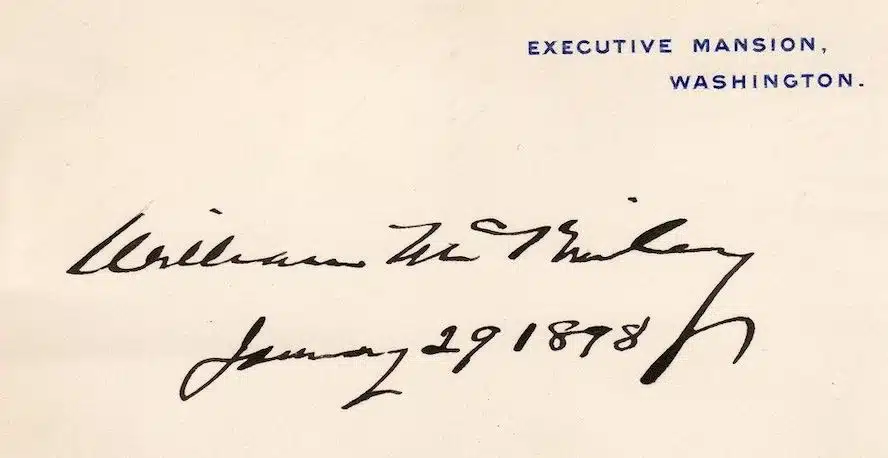
McKinley’s signature was smooth, deliberate, and slightly ornamental, conveying a sense of polish and confidence. The well-formed loops and graceful flow suggest a leader attentive to public image and decorum, reflecting the rising importance of media and public perception during his era.
Yet within the poised strokes lies the determination of a president navigating war, expansion, and rapid change at the dawn of the twentieth century.
🌍 Progressive Era & World Wars (1901–1945)
Theodore Roosevelt
- Term: 1901–1909
- Party: Republican
- Historical role: Twenty-sixth U.S. president, Progressive Era icon, conservationist
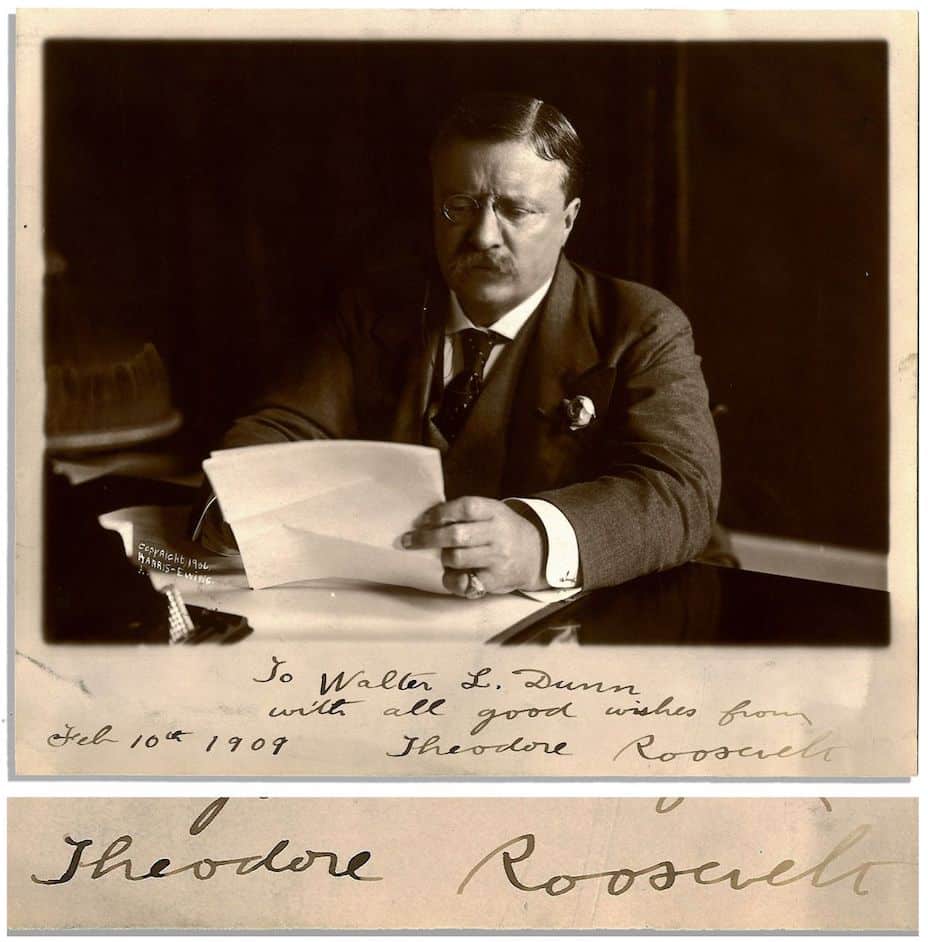
Roosevelt’s signature was energetic and forceful, with vigorous strokes and bold lines that captured his legendary dynamism. The sharp angles and confident sweep reflect his “bully pulpit” style and boundless enthusiasm for reform. His handwriting pulses with vitality, embodying his larger-than-life persona and relentless drive for progress.
William H. Taft
- Term: 1909–1913
- Party: Republican
- Historical role: Twenty-seventh U.S. president, later Chief Justice of the Supreme Court
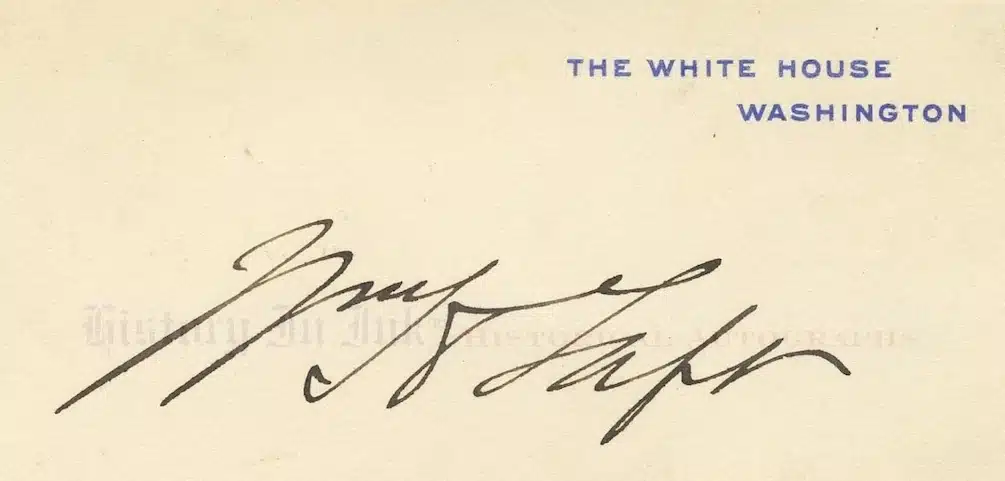
Taft’s signature was rounded, controlled, and neatly spaced, conveying deliberation and balance. The measured curves reflect his legal mind and preference for consensus over confrontation.
As both president and later chief justice, his careful handwriting symbolizes a career devoted to thoughtful governance and constitutional order.
Woodrow Wilson
- Term: 1913–1921
- Party: Democratic
- Historical role: Twenty-eighth U.S. president, led nation through World War I, League of Nations advocate
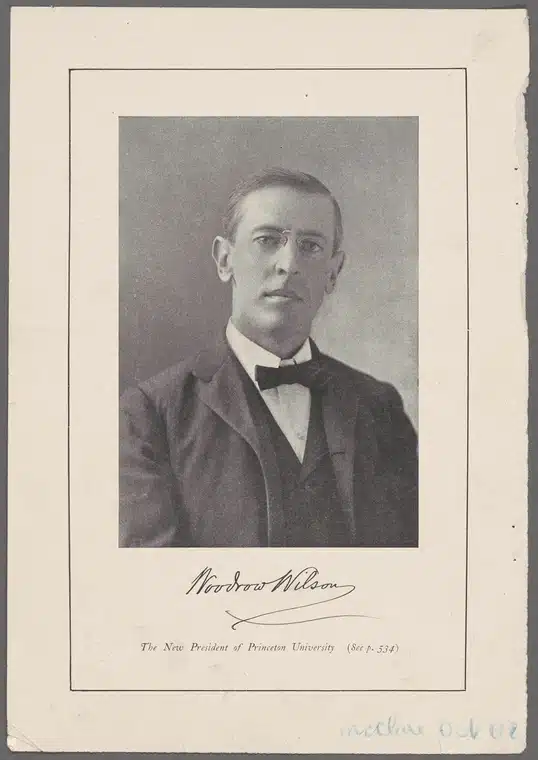
Wilson’s signature was elegant, fluid, and slightly right-slanted, radiating intellect and idealism. The graceful formation reveals a reflective scholar-president, passionate about ideas and principles.
Yet, beneath the sophistication lies the firmness of a leader who reshaped America’s global role — for better or worse.
Warren G. Harding
- Term: 1921–1923
- Party: Republican
- Historical role: Twenty-ninth U.S. president, post-WWI “return to normalcy”
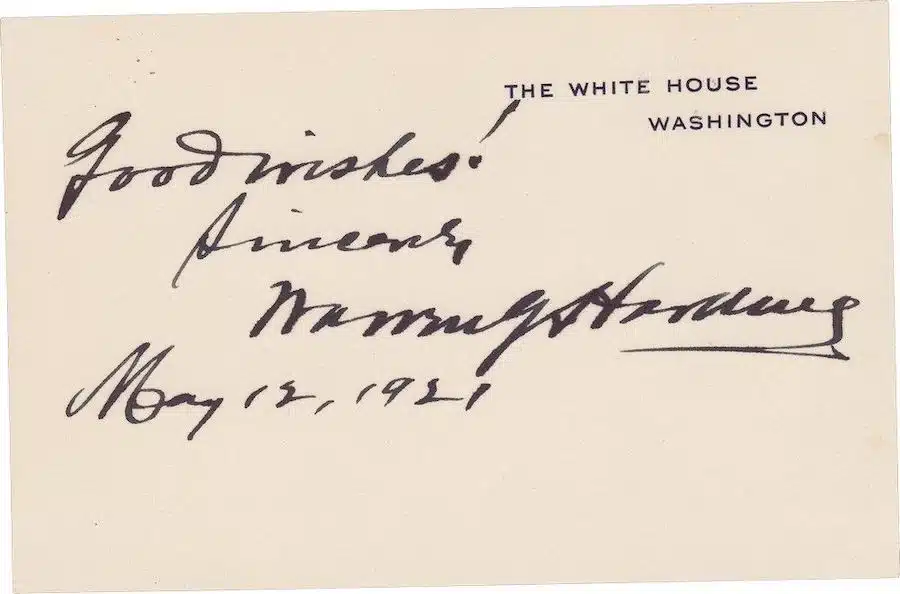
Harding’s signature was bold, slightly flamboyant, and generously looped, reflecting his charismatic public image. The flourish suggests charm and a desire to please — yet perhaps also a lack of the disciplined rigor needed to navigate scandals that marred his presidency.
Calvin Coolidge
- Term: 1923–1929
- Party: Republican
- Historical role: Thirtieth U.S. president, champion of small government, “Silent Cal”
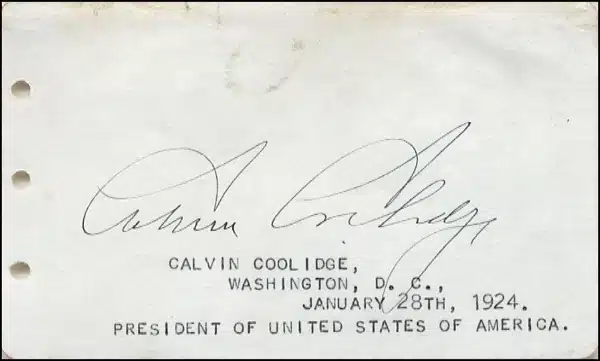
Coolidge’s signature was small, neat, and minimalist, mirroring his famously reserved nature. The understated handwriting underscores a man of few words who valued restraint and efficiency, embodying his philosophy that “the business of America is business.”
Herbert Hoover
- Term: 1929–1933
- Party: Republican
- Historical role: Thirty-first U.S. president, led during the onset of the Great Depression
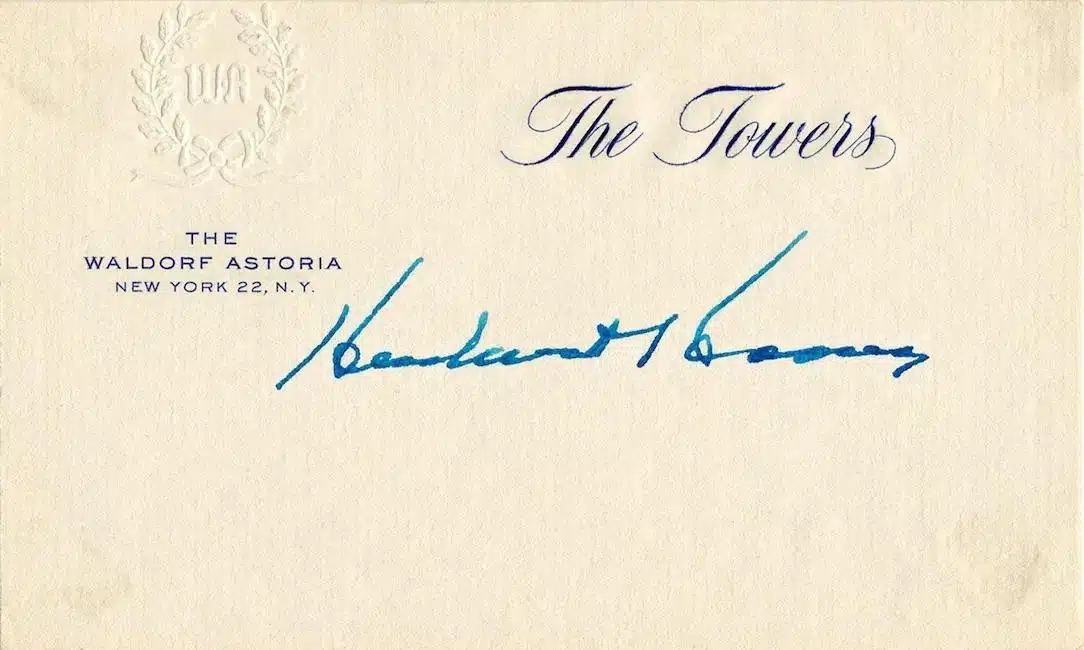
Hoover’s signature was tight, slightly cramped, and highly legible, signaling precision and a strong sense of duty. His handwriting reveals the mindset of an engineer-turned-politician, grappling with unprecedented economic collapse.
The tension between control and chaos seems to echo subtly in the compressed lines of his autograph.
Franklin D. Roosevelt
- Term: 1933–1945
- Party: Democratic
- Historical role: Thirty-second U.S. president, New Deal architect, WWII leader

FDR’s signature was smooth, assured, and expansively looped, radiating optimism and charm. The confident curves reflect his ability to project calm authority during national crises.
His distinctive autograph became a reassuring symbol during the Great Depression and World War II, embodying resilience, adaptability, and visionary leadership.
💥 Postwar to Cold War (1945–1993)
Harry S. Truman
- Term: 1945–1953
- Party: Democratic
- Historical role: Thirty-third U.S. president, ended WWII, dropped atomic bomb, led Marshall Plan
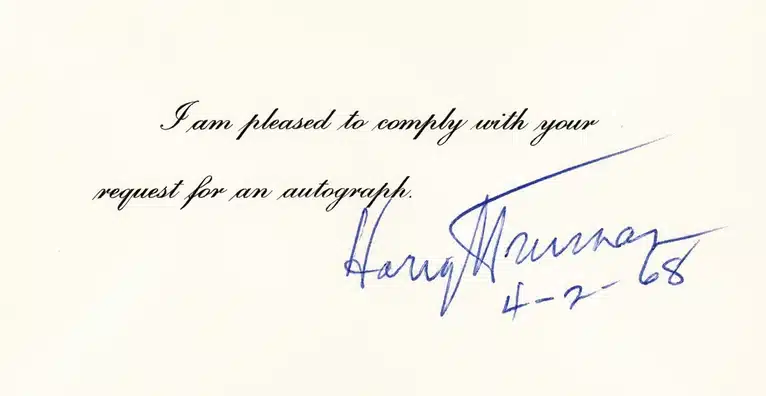
Truman’s signature was practical and straightforward, with compact, upright letters and minimal flair. It reflects his no-nonsense approach, decisiveness, and unpretentious character.
His penmanship mirrors the man who carried the weight of epochal decisions with blunt honesty and resolve.
Dwight D. Eisenhower
- Term: 1953–1961
- Party: Republican
- Historical role: Thirty-fourth U.S. president, WWII Allied Supreme Commander
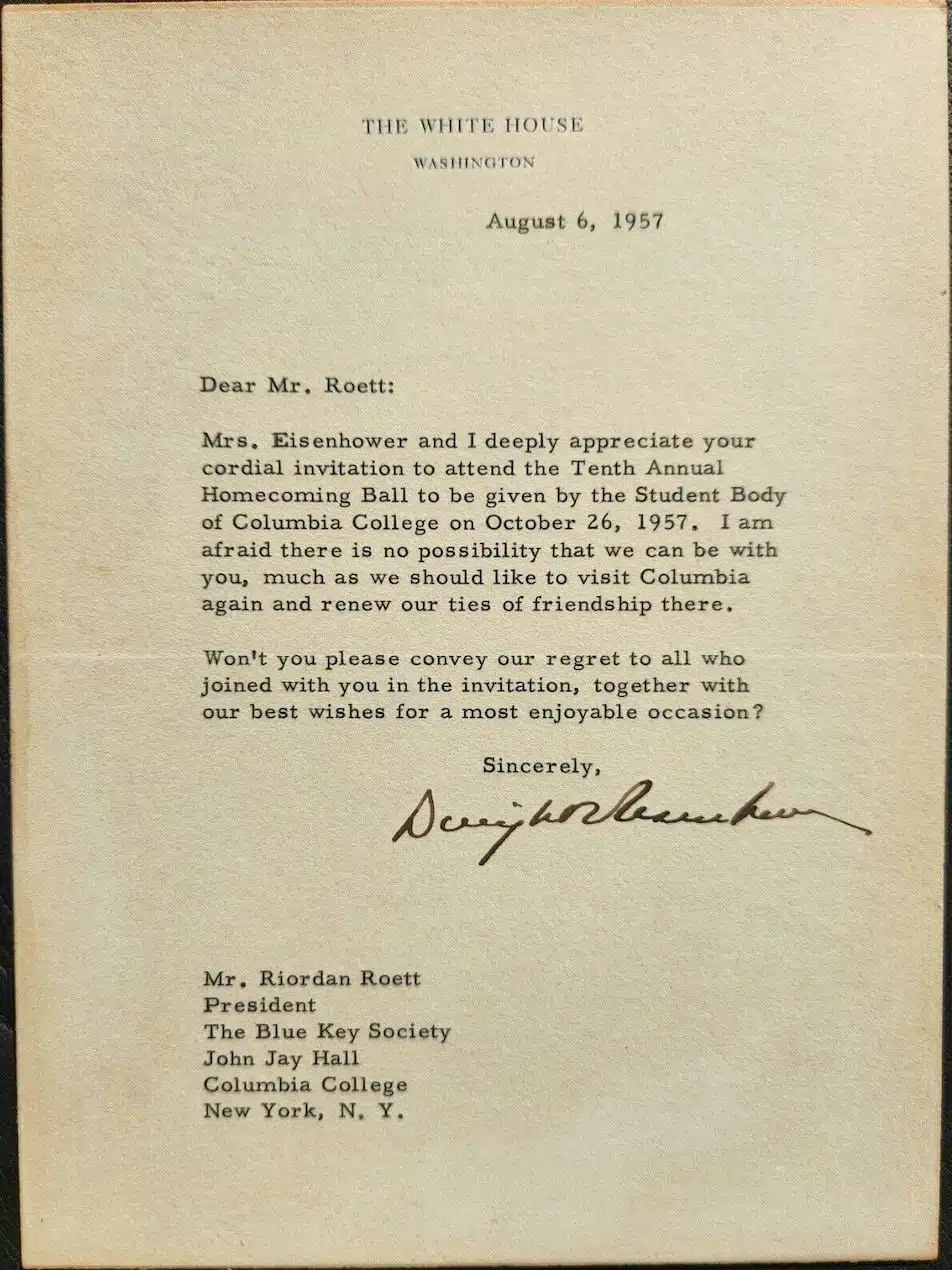
Eisenhower’s signature was firm, evenly spaced, and slightly military in precision, echoing his background as a five-star general. The clean lines convey order, discipline, and an even temperament — qualities that defined his steady leadership during the Cold War.
John F. Kennedy
- Term: 1961–1963
- Party: Democratic
- Historical role: Thirty-fifth U.S. president, Cold War crisis manager, civil rights advocate
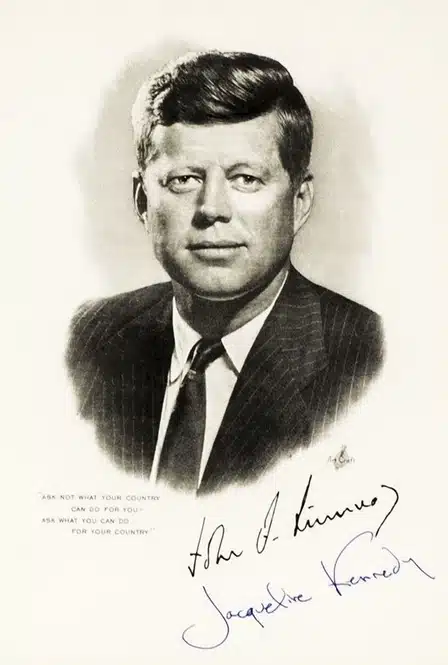
Kennedy’s signature was sleek, stylish, and fluid, reflecting charisma and youthful energy. The graceful loops and confident flow match his public persona as a modern, media-savvy leader. The elegance of his autograph carries a poignant aura, symbolizing promise interrupted.
Lyndon B. Johnson
- Term: 1963–1969
- Party: Democratic
- Historical role: Thirty-sixth U.S. president, Great Society architect, escalated Vietnam War
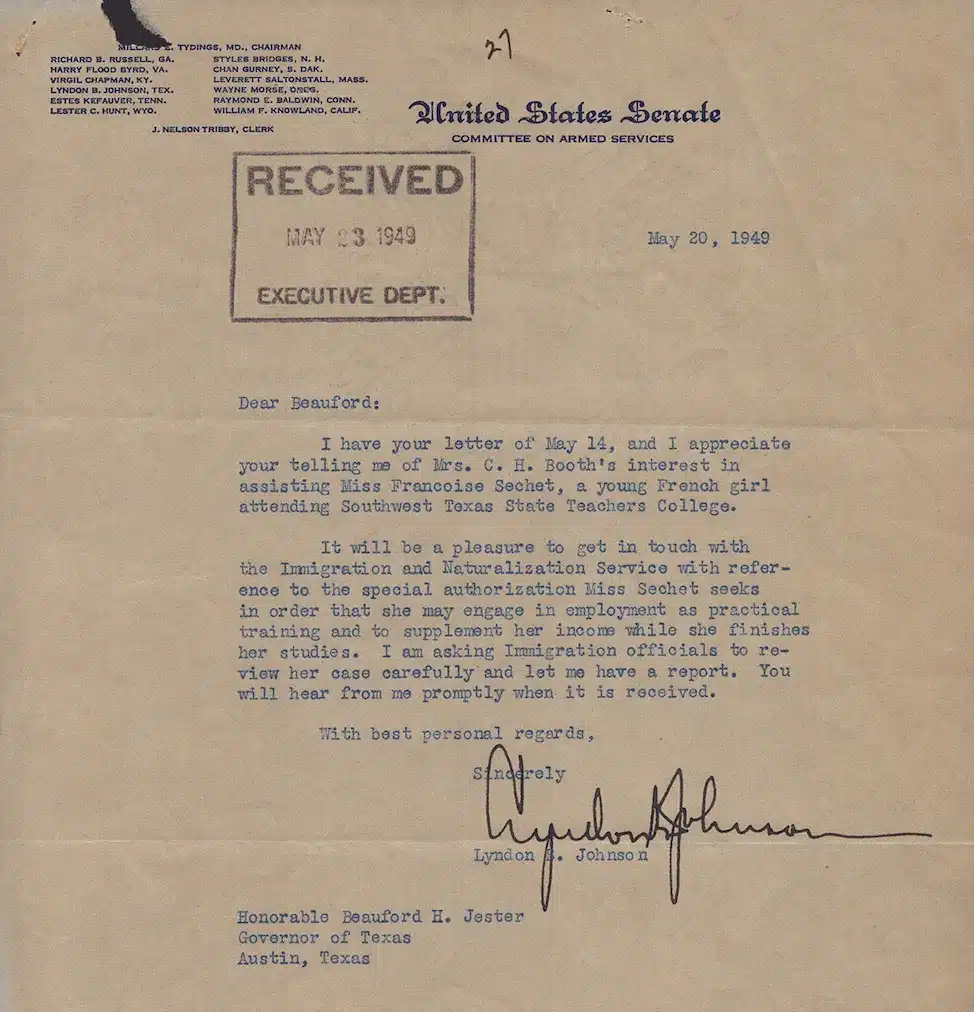
Johnson’s signature was large, bold, and assertive, with heavy strokes that radiate power and authority. His oversized penmanship mirrors his forceful political style — a master of persuasion and pressure, both admired and feared in Washington.
Richard Nixon
- Term: 1969–1974
- Party: Republican
- Historical role: Thirty-seventh U.S. president, opened China, resigned after Watergate
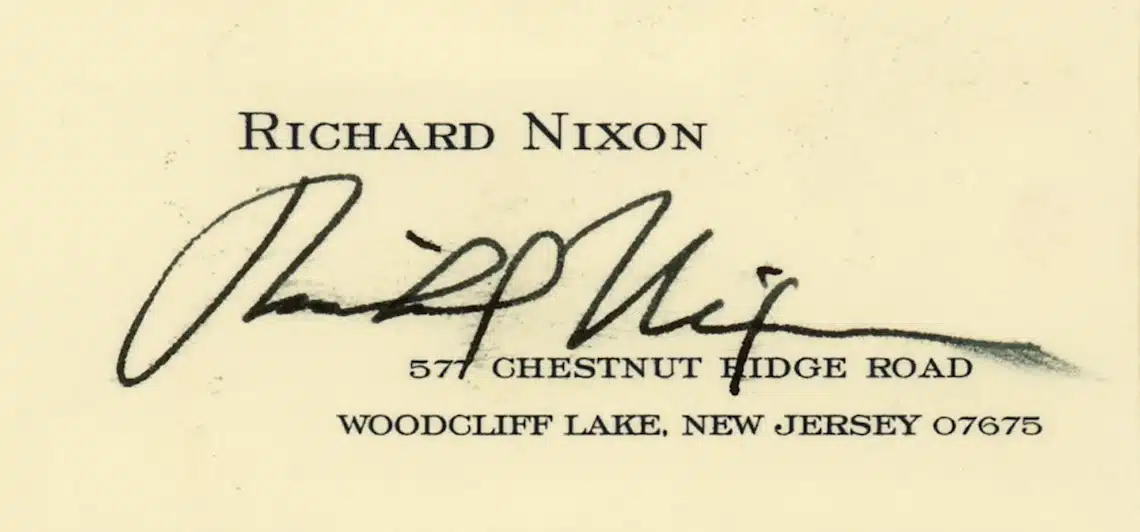
Nixon’s signature was sharp, angular, and slightly restless, reflecting a restless and complex inner world. The tension in his handwriting parallels his deeply ambitious yet ultimately self-destructive trajectory. Even his autograph seems to carry a mix of brilliance and shadow.
Gerald Ford
- Term: 1974–1977
- Party: Republican
- Historical role: Thirty-eighth U.S. president, restored trust post-Watergate
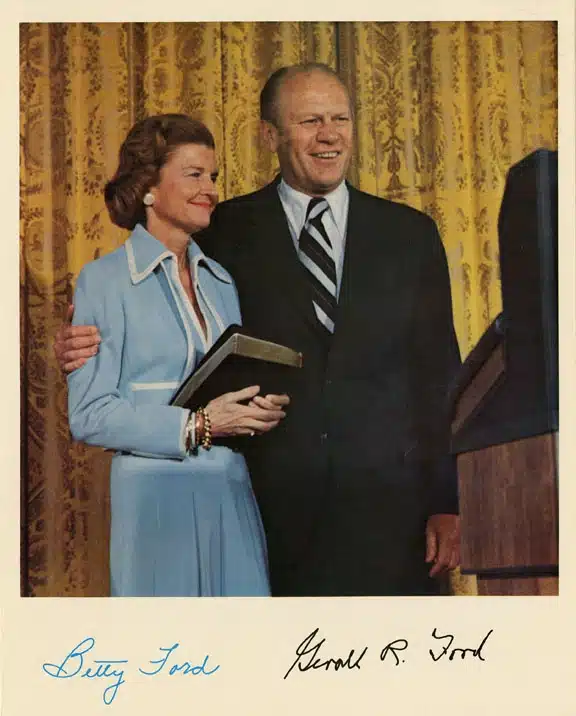
Ford’s signature was clean, balanced, and personable, with clear lettering and gentle curves. It reflects a man of integrity and approachability, known for steadying the nation during a moment of political crisis. The clarity of his autograph aligns with his reputation for honesty and decency.
Jimmy Carter
- Term: 1977–1981
- Party: Democratic
- Historical role: Thirty-ninth U.S. president, human rights advocate, Nobel Peace Prize winner
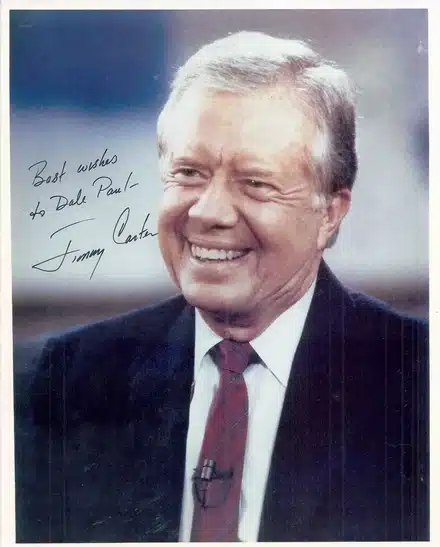
Carter’s signature was simple yet elegant, with modest loops and a slight right slant, embodying humility and sincerity. The unassuming handwriting reflects a deep moral commitment and the soft-spoken style of a president who often prioritized principle over popularity.
Ronald Reagan
- Term: 1981–1989
- Party: Republican
- Historical role: Fortieth U.S. president, Cold War icon, Great Communicator
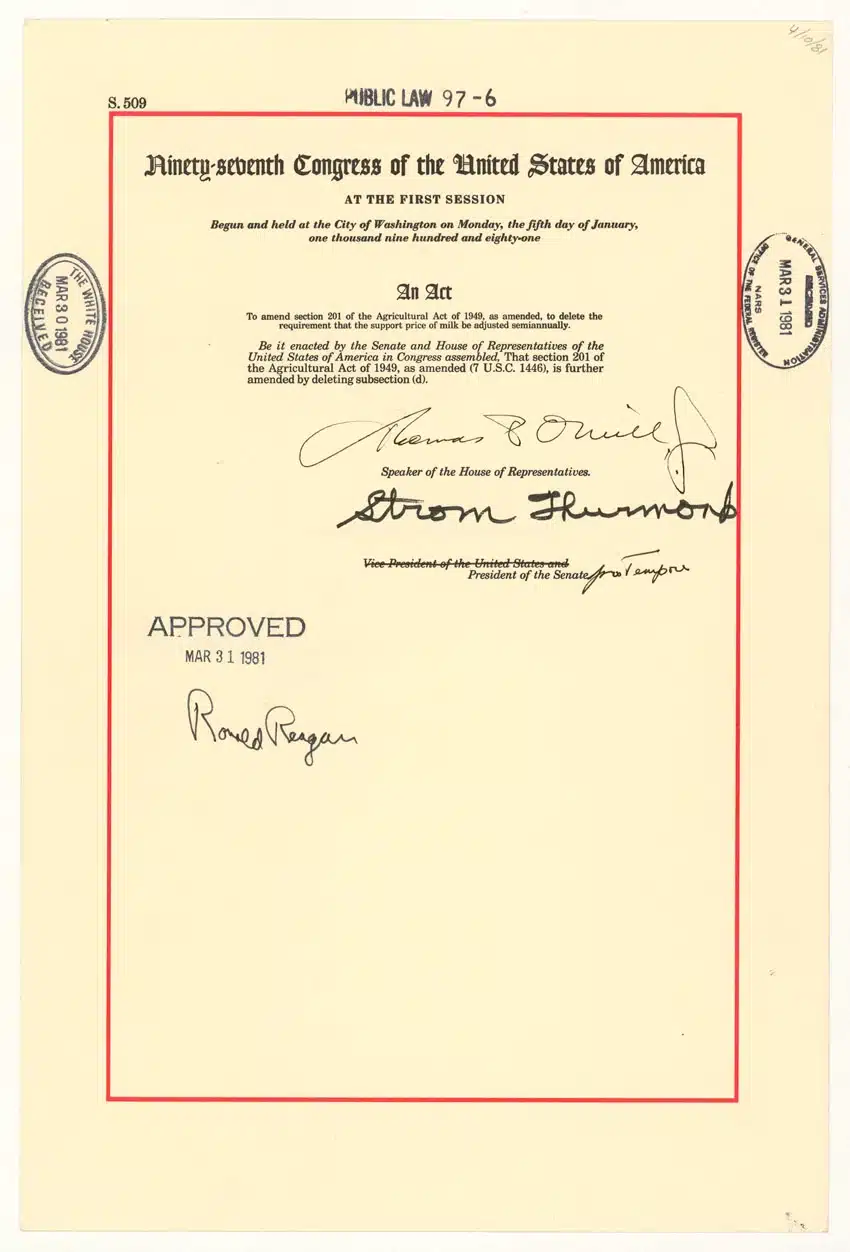
Reagan’s signature was bold, smooth, and flowing, with theatrical flourishes befitting a former actor. It projects charm, optimism, and a touch of showmanship — perfectly capturing the sunny confidence and communication skills that defined his presidency.
George H. W. Bush
- Term: 1989–1993
- Party: Republican
- Historical role: Forty-first U.S. president, Cold War statesman, Gulf War leader

Bush’s signature was neat, restrained, and slightly formal, revealing discipline and diplomatic finesse. The measured, thoughtful penmanship reflects his decades of public service and a leadership style grounded in coalition-building and quiet strength.
🌐 Modern Era (1993–present)
Bill Clinton
- Term: 1993–2001
- Party: Democratic
- Historical role: Forty-second U.S. president, economic expansion, impeachment trial
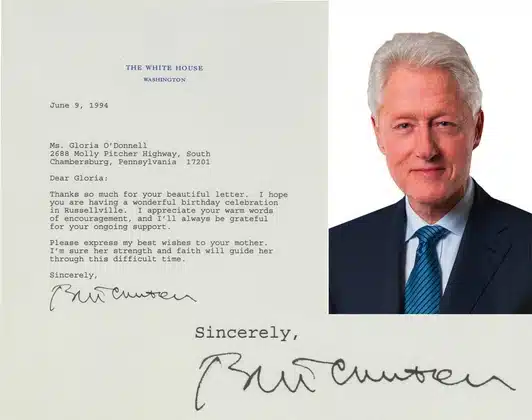
Clinton’s signature was fluid, fast, and slightly playful, with large loops and a dynamic flow that reflect his charisma and adaptability. The lively penmanship mirrors his communication brilliance and ability to connect with diverse audiences, but it also hints at the complexity and contradictions that marked his presidency.
George W. Bush
- Term: 2001–2009
- Party: Republican
- Historical role: Forty-third U.S. president, 9/11 response, Iraq and Afghanistan wars
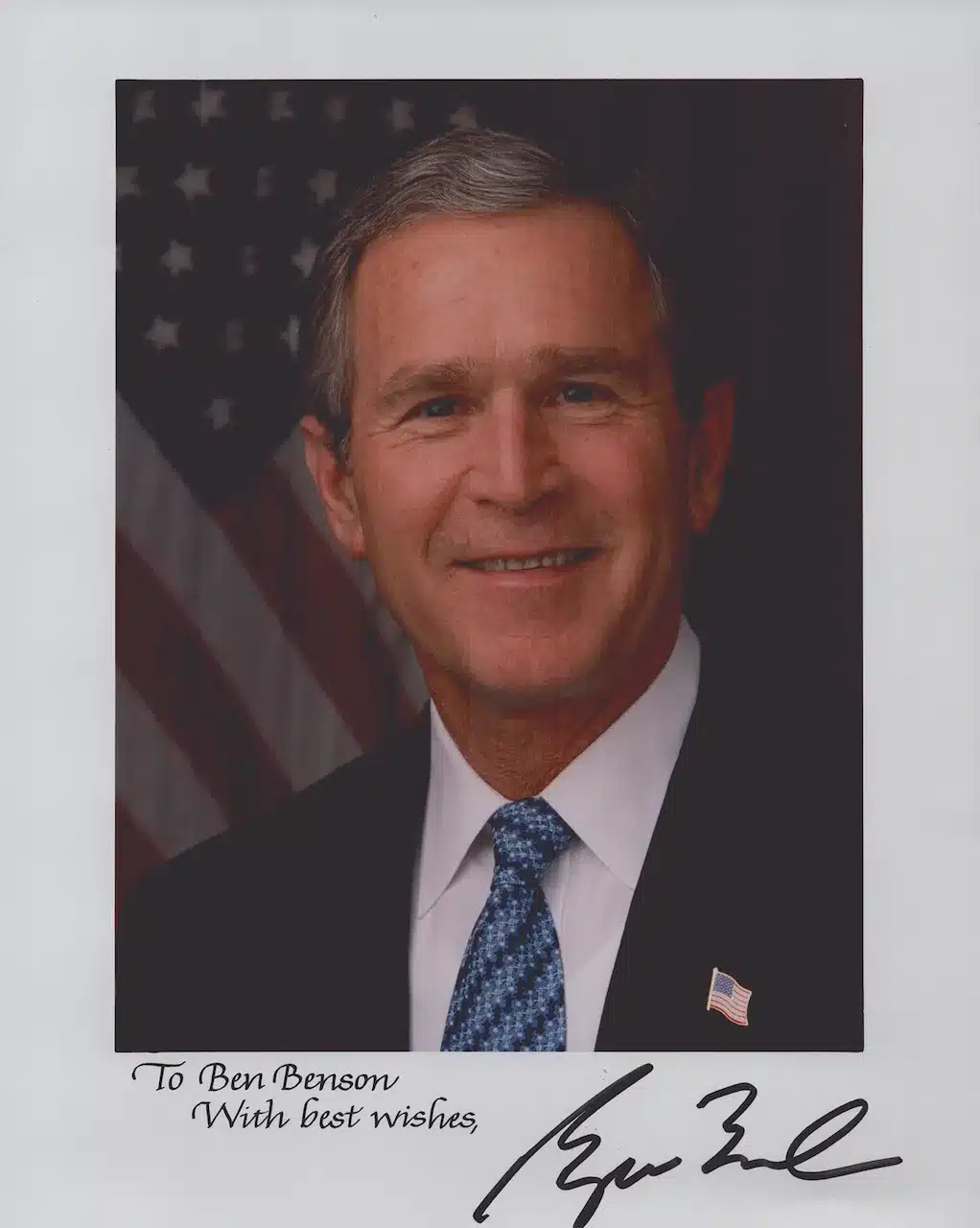
Bush’s signature was straightforward and firm, with a bold “W” that became a recognizable shorthand of his presidency. The uncomplicated style mirrors his reputation for directness and decisiveness, reflecting a leader shaped by crisis and marked by personal resilience.
Barack Obama
- Term: 2009–2017
- Party: Democratic
- Historical role: Forty-fourth U.S. president, Affordable Care Act, first African American president
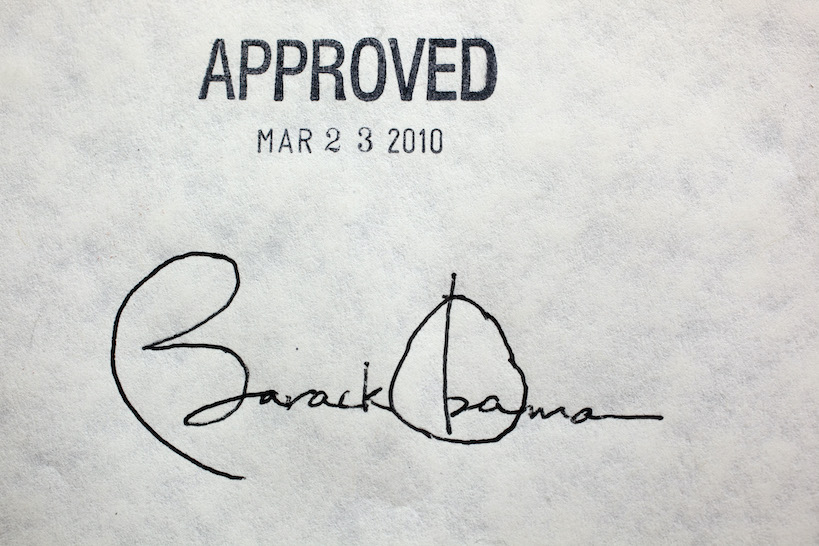
Obama’s signature was sleek, stylish, and highly distinctive, with a looping “O” that became almost iconic. The elegant curves reflect his eloquence, modernity, and attention to image. It conveys a sense of calm control, intellectual depth, and a forward-looking vision that resonated globally.
Want to explore Barack Obama’s signature in depth? Check out our dedicated article on Obama’s signature style, meaning, and history for a closer look.
Joe Biden
- Term: 2021–present (Forty-sixth U.S. president → update to Forty-seventh after Trump reelection, if confirmed)
- Party: Democratic
- Historical role: Forty-sixth U.S. president, veteran statesman, focused on unity and healing
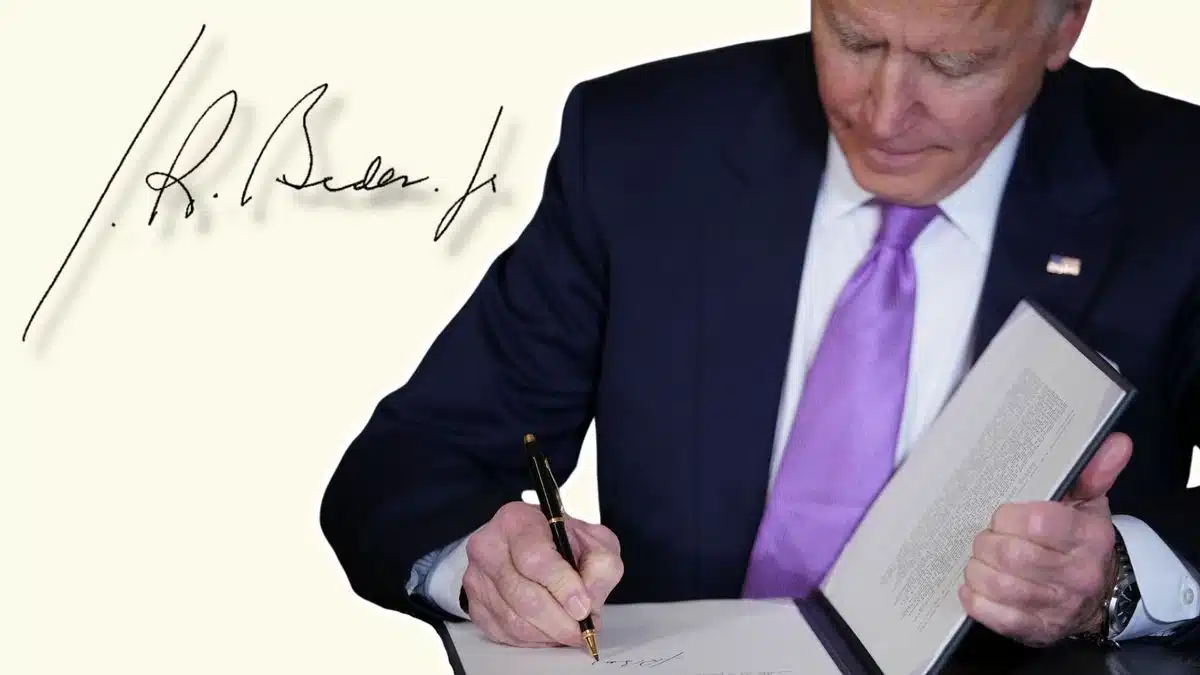
Biden’s signature is gentle, rounded, and slightly hurried, reflecting decades of public service and an approachable demeanor. The informal flow suggests empathy and a people-centered leadership style, while the steady baseline conveys determination through personal and national challenges.
Donald Trump
- 1st Term: 2017–2021
- 2nd Term: 2025–2029
- Party: Republican
- Historical role: Forty-fifth U.S. president, outsider businessman, highly polarized era
Trump’s signature was sharp, jagged, and towering, with exaggerated peaks and deep valleys that command attention. The aggressive, spiky style mirrors his bold, confrontational approach to politics and media.
Few signatures in history so perfectly encapsulate a personality — unapologetic, dominant, and larger-than-life.
Curious about the bold strokes behind Donald Trump’s iconic autograph? Read our full feature on Trump’s signature analysis and personality insights to uncover its secrets.
💥 Why Do Some Presidents Change Signatures?
Presidential signatures aren’t static—they evolve over time, reflecting changes not only in personal style but also in the immense pressures of public life. Some presidents entered office with a carefully practiced autograph, only to see it transformed by the demands of power, media scrutiny, or even physical strain.
For example, Barack Obama’s early signatures were more rounded and leisurely, but as president, his autograph became sleek, swift, and highly stylized—designed to handle the relentless pace of modern governance. Similarly, Franklin D. Roosevelt’s signature grew bolder during World War II, as his public persona hardened under the weight of global conflict.
Changes can also stem from intentional rebranding. Richard Nixon’s signature became sharper and more angular as his political ambitions intensified, reflecting a more assertive public image. On the other hand, health challenges can leave visible marks: Ronald Reagan’s later signatures grew slightly shakier, while John F. Kennedy’s remained remarkably consistent, projecting poise despite chronic health struggles.
This evolution offers a fascinating glimpse into how leadership reshapes personal identity.
Ultimately, these evolving signatures remind us that behind every autograph is a human being navigating unprecedented challenges—and sometimes, even a small change in handwriting can offer a rare glimpse into a president’s private journey.
✍️ Ready to Create Your Own Presidential-Style Signature?
Explore the Calligraphy Signature Generator and design a signature that’s as unique and powerful as your own story. Make your mark today!
🚀 Try the Free Signature Generator🏛️ More Than Ink: What Presidential Signatures Teach Us
More than mere marks on paper, presidential signatures offer a profound window into leadership, ambition, and the shaping of a nation. Each stroke — from Washington’s stately flourish to Biden’s streamlined script — holds lessons about power, resilience, and human character across America’s evolving landscape.
As you reflect on this collection of 47 U.S. presidential signatures, consider what they reveal: the balance between personal identity and public responsibility, the weight of history behind a name, and the timeless art of leaving a mark that endures.
Inspired to create your own signature with meaning and style?
Explore our Calligraphy Signature Generator and craft a signature that’s as unique as your story — because every name has the power to make history.
📚 References & Sources
To ensure historical accuracy and authoritative insights, this article consulted multiple reputable sources, including:
- White House Historical Association → https://www.whitehousehistory.org
Official presidential biographies, historical timelines, and signature archives. - Library of Congress → https://www.loc.gov
Historical documents, manuscripts, and verified autograph records. - National Archives and Records Administration → https://www.archives.gov
U.S. founding documents and presidential archives. - Smithsonian Institution → https://www.si.edu
Exhibits and studies on U.S. presidents, artifacts, and cultural history. - Sotheby’s & Christie’s Auction Houses → https://www.sothebys.com, https://www.christies.com
Market valuation and authenticity benchmarks for presidential autographs.
💡 Explore Unique Signature Ideas
- 📚 Signature Dictionary (A–Z)
- 🟢 20+ Coolest Signatures
- 🌈 10+ Billionaire Signatures
- 63 Famous Painter Signature Examples
- 60 Doctor Signature Examples
- 30+ Teacher Signature Examples
- 👨👨👦👦 50+ Famous Signature Examples
- 🖼️ Signature Gallery
- 🌟 Best Signature Styles for My Name
- 25+ Infinity Signature Ideas & Unique Autograph Samples
- 35+ Simple Signature Ideas: Best, Easy & Minimalist Examples
- 30+ Signature Suggestions for My Name: Creative Ideas
- 💡 100+ Sample Signature Ideas

